Life under the waves has truly evolved some strange and beautiful fish. One of the odder developments that you’ll see in aquatic life are fish that have characteristically large foreheads.
We’re not even sure in some cases why this trait evolved – while some fish use them to get the attention of mates, in some cases they seem entirely ornamental.
Today we’re going to take a look at 12 popular fish with big forehead and you can see what we mean. These little characters are definitely quite the lookers and just another example of the many wonders you’ll find beneath the waves.
We’ve compiled some beauties for you and below you’ll find the fish that we’ll be telling you about today:
- Asian Sheepshead Wrasse
- Front cichlid
- Midas Cichlid
- Green Humphead Parrotfish
- Mahi-Mahi
- Oranda
- Napoleon fish
- Lionhead cichlid
- Humphead Glassfish
- Hump-headed Blenny
- Flowerhorn fish
- Barreleye Fish
Without further ado, let’s get a closer look at each of these characters so that you can learn more about these big-headed beauties!
Contents
Popular Fish With Big Forehead
Also read:
1. Asian Sheepshead Wrasse
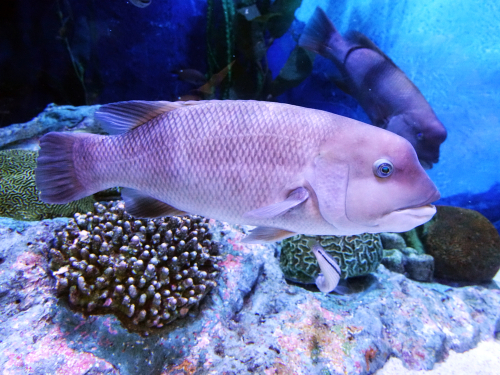
- Scientific name: Semicossyphus reticulatus
- Diet: Mostly shellfish; such as oysters, blue crabs, shrimp and other tiny crustaceans, and the occasional small fish.
Found mainly in China and Japan, and less-commonly in North and South Korea, the Asian Sheepshead Wrasse is a reef fish with quite the distinctive forehead. They are also a bit on the large side, measuring in at an average length of 35.4 to 39.3 inches.
Aside from their distinctive foreheads, these fish also have quite prominent chins, but one of the stranger facts about these fish is that the Japanese-based varieties are all sequentially hermaphroditic.
Born as females, they can become males later in life, and upon finding a mate the pair will leave fertilized eggs in the coral reefs and the cycle of life begins anew.
2. Front cichlid
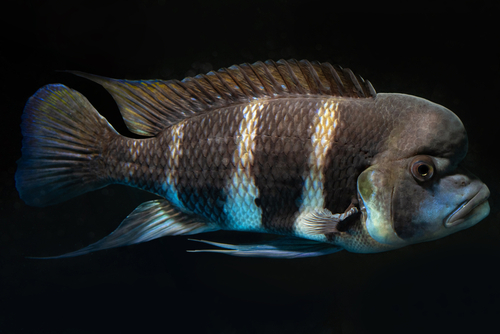
- Scientific name: Cyphotilapia frontosa
- Diet: Snails and mollusks in the wild, but in a tank they will eat pellets, small crustaceans, brine shrimp, and worms.
Front Cichlids are beautiful fish that are native to East Africa and which may grow up to 1.1 foot long, even in captivity. Until they reach 3 years of age, it’s actually very hard to determine their gender, as the fish will have identical markings that don’t really give this away.
At the 3-year mark, the nuchal hump will begin developing, but only on the males and that’s the clearest physical sign that you’ll see to indicate the fish’s gender.
Their markings are really uite lovely, being abase of white or blue, with 7 vertical bars of color along with assorted spots and splotches on the fins and the tail.
Front Cichlids are not just beautiful, though, but also quite hardy, with a potential lifespan of up to 25 years! As you can imagine, this robust health and their relatively modest size makes them quite popular with aquarium hobbyists around the world!
3. Midas Cichlid
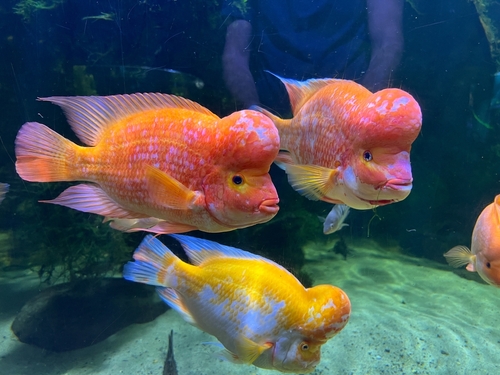
- Scientific name: Amphilophus citrinellus
- Diet: Mollusks, plant materials, small fish, and insect larvae are favorite foods of the Midas Cichlid.
Like Front Cichlids, Midas Cichlids reach a mature length of just over 1 foot, with a weight of around 2.5 pounds. — although the males tend to be just a touch larger than the females.
You can find these fish in both Tropical and Central America, and they are also quite populous in the U.S. state of Florida.
Born somewhat gray in tone, Midas Cichlids colorize wonderfully as they age, and in time both the male and the female will develop a nuchal hump, though the males will be much more prominent. It’s also interesting to note that the hump is only visible part-time.
During breeding season, you’ll see it, but once that’s over then the hump will diminish in size until it’s time for the fish to attract a mate again and raise the next generation of Midas Cichlids.
4. Green Humphead Parrotfish
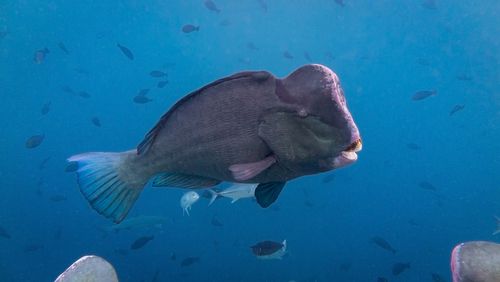
- Scientific name: Bolbometopon muricatum
- Diet: Green Humpheads have a specialized diet consisting mostly of live corals and benthic algae.
The largest species of Parrotfish, Green Humped Parrotfish can grow to a whopping size of 4.9 feet, with a weight of approximately 165 pounds!
While you might see them in public aquariums, to spot them otherwise you’ll need to visit them on a dive in the Red Sea or the waters in the Indo-Pacific that they like to frequent.
The best place to find them is seaward reefs and clear, outer lagoons, and there will need to be corals as this is what they like to eat!
Nature has given the Green Humphead Parrotfish the means to do so in the form of a fused-teeth structure that functions essentially the same way as a parrot’s beak.
This allows the Parrotfish to crush and break the hard corals in order to enjoy a delicious meal. Their forehead hump, interestingly enough, is quite a bit more functional than with other fish.
Green Humpheads can actually use it to break off chunks of coral and during mating season, they’ll even trade headbutts with competing males.
They are also quite the long-lived species, with the potential to live to a ripe old age of 40 years old or maybe even a little more!
5. Mahi-Mahi
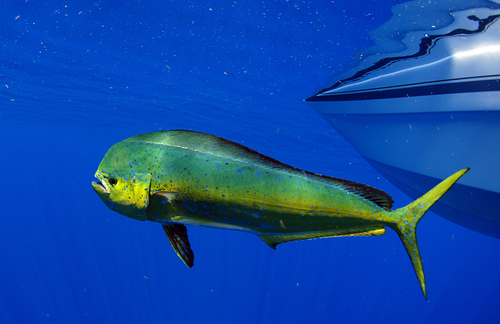
- Scientific name: Coryphaena hippurus
- Diet: Small ocean fish such as triggerfish, flying fish, sargassum, and the occasional man-o-war are all popular staples of the Mahi-Mahi’s diet.
Also known as Dolphinfish, you can find Mahi-Mahi in the Atlantic, Pacific, and Indian oceans where the water is warm, and they are modestly sized fish – averaging approximately 33 to 55 inches in length and weighing 15 to 40 pounds fully-grown.
As far as a forehead bump, this trait only occurs in the males, while the females will have more rounded heads. Both genders display amazing coloration, in bright blue or a mix of mossy and light greens.
While beautiful, these fish are not very long lived, with a potential lifespan of 5 years but a typical one of only 2 years.
Still, one might attribute this to ‘fast living’, as Dolphinfish are quite the speedy swimmers, reaching a breakneck pace of up to 60 miles per hour when they need to. As they are prey for sharks, billfish, and other predators, that speed definitely comes in handy!
6. Oranda

- Scientific name: Carassius auratus auratus
- Diet: Little opportunists, Oranda goldfish will eat just about anything, with plant materials, smaller fish, tiny crustaceans, or simply pellets or flake foods all being popular options for these fish.
The Oranda goldfish definitely has a distinctive forehead in the form of a bubble that forms upon it that can extend to the point that it encases the face!
While popular worldwide, their origins are in Japan where they were specifically bred – as such, you won’t find them in the wild, but only in pet stores or through local breeders.
Though big in character, these are small fish, an average adult length of 8 to 12 inches, and they are fairly robust little characters, living to be as old as 20 years if you provide them with a large enough enclosure or pond.
That said, if you intend to keep them, it’s good to give them company, as these fish are happiest living in groups of 8 so that they may interact and school together in their new home.
7. Napoleon fish
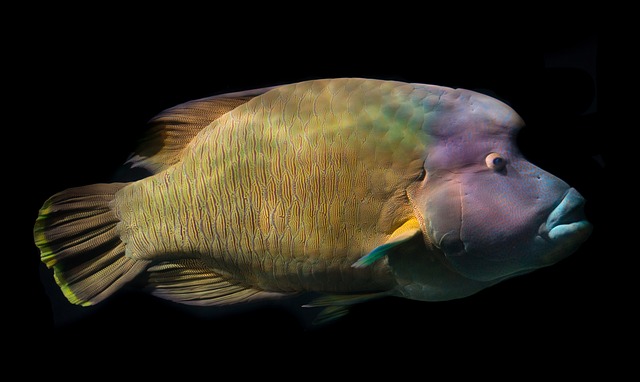
- Scientific name: Cheilinus undulatus
- Diet: In the wild, Napoleon fish dine on burrowing worms, shellfish, sea urchins, sea stars, and crabs.
Reef-dwelling fish found natively in the Inco-Pacific, Napoleon fish may reach an adult length of up to 7.5 feet but despite this modestly-impressive size, they are on the endangered species list due to overfishing, but left alone they can reach an age of up to 30 years.
Like the Asian Sheepshead Wrasse, Napoleon fish are born female but may change their gender when they are older, although typically one male will be responsible for fertilizing the local females unless one is not available – in which case, the largest female will change her gender.
Interestingly enough, their colors change by age, with a young female typically being bright orange until around the age of 9 years old, when they will become a bright green or blue male!
8. Lionhead cichlid
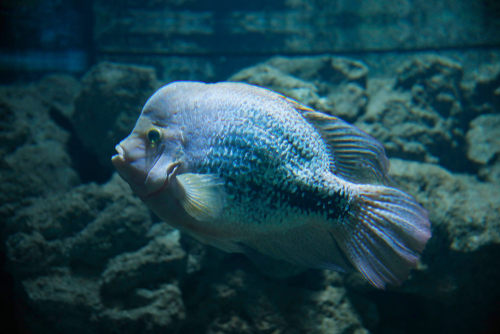
- Scientific name: Steatocranus casuarius
- Diet: Lionhead cichlids are omnivorous, eating small crustaceans, algae, plant, plankton, and fish flakes.
Also known as the ‘African Buffalo head’ or the ‘Blockhead Cichlid’, Lionhead Cichlids are a great addition to any tank, as they only reach a manageable adult length of about 4 ½ inches.
Native to eastern Africa and also found in South America throughout the Amazon region, these little fish are quite colorful, typically showing olive-green or even blue coloration, and the hump that you’ll sometimes see on one of these fish indicates that you are looking at a male.
While peaceful with most other fish, they can be quite territorial with other Lionheads, and if you take good care of them they can live to be as old as 10 years or even a little more.
9. Humphead Glassfish
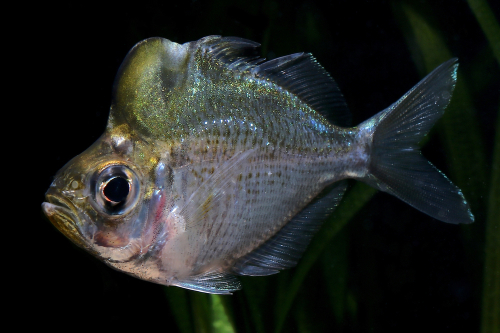
- Scientific name: Parambassis pulcinella
- Diet: Humphead Glassfish are carnivorous, eating mostly small shrimp and fish, as well as insect larvae when they find it.
Native to western Thailand and Southeast Myanmar, the Humphead Glassfish looks like a small, silver or bronze and silver ghost, with black eyes and spots of purple seen at the gills, along with an enormous hump just above the forehead.
While they only grow to be about 3.9 inches long, these little fish are hardy, and may live anywhere from 3 to 8 years in captivity… just be sure to give them a large tank and with a little care, your own Humphead Glassfish will quickly grow and thrive.
10. Hump-headed Blenny
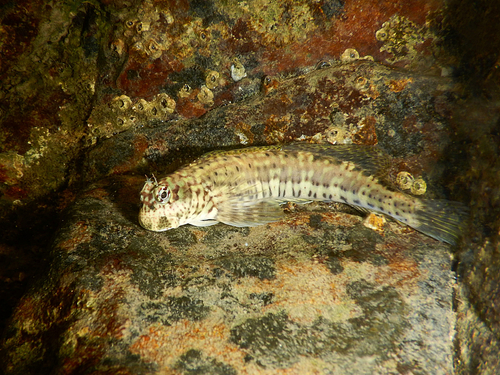
- Scientific name: Blenniella gibbifrons
- Diet: In the wild, Hump-headed Blennies like to eat planktons and large amounts of algae, but in captivity they will eat algae and fish pellets and flakes.
Blennies, also known as ‘bullethead rockskippers’, are reef fish that are found natively at the Ducie, Line, and Hawaiian Islands, as well as in the Indian and Pacific oceans.
The good news, if you are trying to spot one in the wild, is that they like to dwell in shallows – with 1.6 to 4.9 feet being the ideal depth for these fish.
You’ll have to look closely at the sands in the water below to find them – as these fish are only about 4.7 Inches long!
Thankfully, you can purchase them commercially if you like the look of these fish and keep them at home. They are surprisingly tolerant of a wide range of temperatures, so they’re quite easy to keep. Just be sure to cover the tank, as Blennies are known to be quite the lively jumpers!
11. Flowerhorn Cichlids
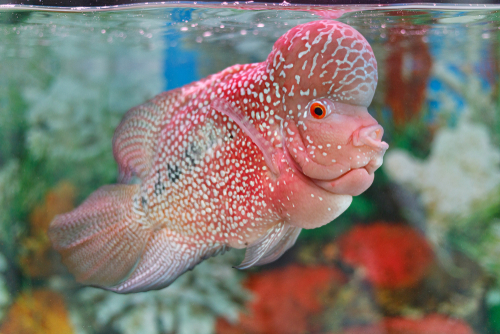
- Scientific name: Paraneetroplus synspilus
- Diet: Flowerhorn fish are omnivores, and eat a diet of small fish, shrimp, plant matter, and in captivity they enjoy vegetables and cichlid pellets.
Flowerhorn Cichlids are bright and colorful and definitely have noticeably foreheads, with great big bulbs and a color range that only comes from specific breeding.
This species was artificially bred for it’s beauty and is a ‘hybrid of a hybrid’, so to speak, as it was originally bred by mixing other species with Blood Parrot Cichlids.
Blood Parrots themselves are hybrids of a number of Cichlid species from Central America, and so you’ll find all kinds of Flowerhorns in a very colorful range. These fish are not just beautiful, though, but also hardy, with a lifespan averaging between 10 and 12 years.
12. Barreleye Fish
- Scientific name: Macropinna microstoma
- Diet: Barreleye fish like to dine on plankton, siphonophores, jellies, and assorted tiny crustaceans.
Our last fish is an amazing one, but you definitely won’t see it in a home aquarium. The deep sea Barreleye fish not only has a prominent forehead, but a transparent one! These fish actually have a dome at the front of their heads that is slightly blue and completely transparent!
It’s quite the wonder, but sadly as they are used to the high pressure of the deep-sea depths, they’re not something that you can host at home – we simply don’t have the technology yet to produce the pressures found at 2500 meters (close to half a mile) below where these little wonders live.

Ian Sterling, founder of Fishlab.com, began his aquarium journey over 30 years ago, driven by a deep fascination for fish and their diverse personalities. His website, Fishlab.com, is dedicated to making fishkeeping accessible and enjoyable, offering beginner-friendly guidance, expert insights, and a community for aquarists to connect and share experiences.

